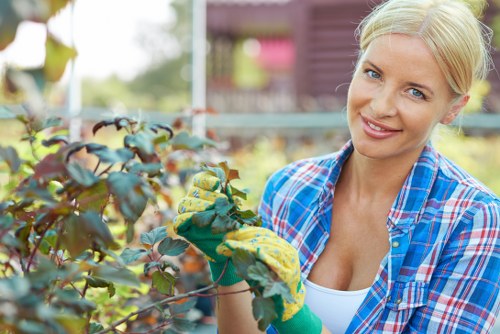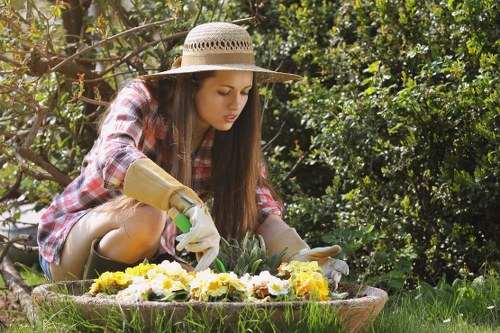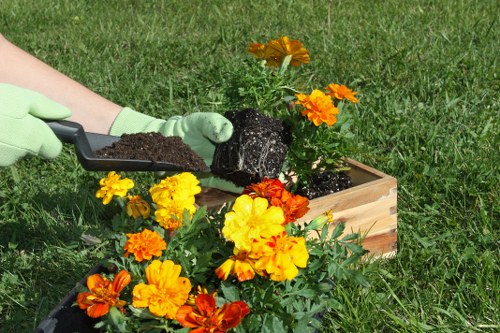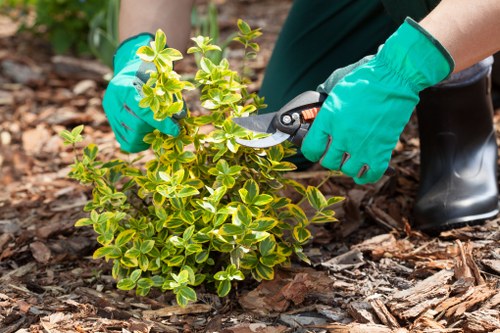Hedge Trimming in Barkingside
Introduction to Hedge Trimming

Hedge trimming is an essential aspect of garden maintenance that not only enhances the aesthetic appeal of your property but also promotes the health and longevity of your hedges. In Barkingside, where lush greenery adorns many homes, maintaining well-trimmed hedges can significantly boost your garden's overall appearance.
Regular trimming helps in controlling the size and shape of your hedges, ensuring they complement the architecture of your home and landscape. Whether you have a small front garden or a sprawling backyard, proper hedge maintenance can make a substantial difference.
Understanding the best practices for hedge trimming is crucial for achieving optimal results. This guide delves into the various aspects of hedge trimming in Barkingside, offering valuable insights for both novice gardeners and seasoned landscapers.
The Importance of Regular Hedge Trimming

Maintaining your hedges through regular trimming offers numerous benefits that extend beyond mere aesthetics. Here are some key reasons why hedge trimming is vital:
- Promotes Healthy Growth: Trimming encourages new growth by removing old or dead branches, allowing more sunlight and air to reach the plant.
- Enhances Curb Appeal: Well-maintained hedges add structure and beauty to your garden, increasing your property's overall appeal.
- Prevents Overgrowth: Regular trimming keeps your hedges in check, preventing them from encroaching on pathways or structures.
- Reduces Pest Infestations: By removing diseased or damaged branches, you minimize the risk of pests and diseases taking hold.
In Barkingside, where gardens are a common sight, maintaining healthy hedges can set your property apart, showcasing meticulous care and attention to detail.
Moreover, well-trimmed hedges can serve functional purposes, such as providing privacy, acting as windbreaks, and defining garden boundaries. These benefits make hedge trimming an indispensable part of garden upkeep.
Best Times to Trim Hedges in Barkingside

Timing plays a crucial role in the effectiveness of hedge trimming. Trimming at the wrong time can stress the plants, leading to poor growth or even damage. In Barkingside, the optimal times for hedge trimming are typically:
- Late Winter to Early Spring: This period allows hedges to recover quickly as the growing season begins, promoting vigorous new growth.
- Late Summer: Trimming during this time helps maintain the desired shape and size before the onset of colder weather.
- Post-Flowering: For flowering hedges, trimming after they have bloomed ensures that the plants have enough time to recover and prepare for the next flowering cycle.
It's essential to consider the specific type of hedge you have, as some species may have unique trimming requirements. Always refer to local gardening guidelines or consult with a professional to determine the best trimming schedule for your hedges.
Additionally, avoiding extreme weather conditions during trimming can prevent unnecessary stress on the plants. Gentle weather conditions are ideal for ensuring a smooth and effective trimming process.
Essential Tools for Hedge Trimming

Having the right tools is fundamental to achieving precise and effective hedge trimming. Investing in quality equipment not only makes the job easier but also ensures the health and safety of your hedges. Here are some essential tools you should consider:
- Hedge Trimmers: Available in manual, electric, and gas-powered versions, hedge trimmers are indispensable for maintaining hedge shapes and sizes.
- Pruning Shears: These are ideal for detailed trimming and removing smaller branches that bulkier trimmers might miss.
- Loppers: For thicker branches, loppers provide the necessary leverage and cutting power.
- Gloves and Protective Gear: Protecting your hands and eyes is crucial to prevent injuries while trimming.
- Ladders or Scaffolding: For tall hedges, having a stable platform ensures safe and effective trimming.
In Barkingside, where garden sizes and hedge types can vary, selecting the appropriate tools for your specific needs is essential. High-quality tools can make a significant difference in the ease and efficiency of your hedge trimming tasks.
Regular maintenance of these tools, such as sharpening blades and proper storage, will extend their lifespan and ensure they perform optimally when needed.
Popular Hedge Trimming Styles

Hedge trimming is not just about maintaining plants; it's also an art form that can enhance the aesthetic appeal of your garden. Here are some popular trimming styles commonly used in Barkingside:
- Formal Style: Characterized by clean lines and geometric shapes, this style is ideal for maintaining a structured and orderly garden appearance.
- Natural Style: Emphasizes the natural growth patterns of the hedge, providing a more relaxed and organic look.
- Topiary: Involves shaping hedges into intricate designs or figures, adding a creative and decorative element to your garden.
- Thinning: Focuses on removing select branches to improve light penetration and air circulation, promoting healthier growth.
Choosing the right style depends on your personal preferences, the type of hedge, and the overall design of your garden. Professional hedge trimming services in Barkingside can help you achieve the perfect look tailored to your specific needs.
Incorporating these styles thoughtfully can transform your hedges from simple plants to key features of your garden landscape.
Hiring a Professional Hedge Trimmer in Barkingside

While DIY hedge trimming is possible, hiring a professional offers several advantages, especially for larger or more complex gardens. Here's why you should consider professional hedge trimming services in Barkingside:
- Expertise: Professionals have the knowledge and experience to trim hedges accurately, ensuring both health and aesthetics.
- Time-Efficiency: Trimming hedges can be time-consuming. Professionals can complete the job swiftly, allowing you to focus on other tasks.
- Safety: Professionals are trained to handle tools safely, reducing the risk of accidents during the trimming process.
- Proper Equipment: Access to high-quality tools and machinery ensures a precise and clean trim.
In Barkingside, numerous landscaping companies specialize in hedge trimming, offering customized services to meet the unique needs of your garden. Hiring a reputable service ensures that your hedges are maintained to the highest standards.
Additionally, professional services often provide follow-up care and maintenance tips, helping you maintain healthy hedges between trimming sessions.
Cost of Hedge Trimming in Barkingside

The cost of hedge trimming in Barkingside can vary based on several factors. Understanding these can help you budget effectively for your garden maintenance needs:
- Size of the Hedges: Larger hedges require more time and effort, increasing the overall cost.
- Type of Hedge Plant: Some plants may be more challenging to trim and require specialized tools or techniques.
- Frequency of Trimming: Regular maintenance contracts may offer discounted rates compared to one-time services.
- Additional Services: Services such as hedge shaping, removal of debris, or pest control can add to the overall cost.
- Accessibility: Hedges in hard-to-reach areas may require additional equipment, influencing the price.
On average, residents in Barkingside can expect to pay between £50 to £150 for standard hedge trimming services, depending on the aforementioned factors. Obtaining multiple quotes from different service providers can help you secure the best value for your investment.
It's also advisable to inquire about any potential discounts or package deals that may be available, especially if you require regular maintenance.
DIY Hedge Trimming Tips

If you prefer to undertake hedge trimming yourself, here are some practical tips to ensure success:
- Plan Your Trim: Visualize the desired shape and size of your hedges before starting. Use strings or stakes to outline the shape if necessary.
- Use the Right Tools: Ensure your hedge trimmers and other tools are sharp and in good condition to achieve clean cuts.
- Trim in Stages: Start with the sides, then move to the top, maintaining symmetry and balance throughout.
- Remove Dead or Diseased Branches: Carefully prune any unhealthy sections to promote better growth.
- Maintain Consistent Angles: Keeping a consistent angle ensures a uniform and professional appearance.
Safety should always be a priority. Wear protective gear, such as gloves and safety glasses, and be cautious when using sharp tools or working at heights.
Regular practice and attention to detail can help you master the art of DIY hedge trimming, resulting in beautifully maintained hedges that enhance your garden's appeal.
Environmental Benefits of Proper Hedge Trimming

Beyond aesthetic and health advantages, proper hedge trimming also contributes to environmental sustainability. Here's how:
- Promotes Biodiversity: Healthy hedges provide habitats for various insects, birds, and other wildlife, supporting local ecosystems.
- Reduces Carbon Footprint: Maintaining healthy plants enhances their ability to sequester carbon dioxide, aiding in pollution reduction.
- Manages Pests Naturally: Proper trimming reduces the likelihood of pest infestations, minimizing the need for chemical pesticides.
- Enhances Air Quality: Well-maintained hedges improve air circulation and help filter pollutants, contributing to a healthier environment.
In Barkingside, where environmental consciousness is on the rise, adopting sustainable garden practices, including responsible hedge trimming, can make a positive impact on the community and the planet.
Implementing eco-friendly trimming techniques, such as using manual tools or electric trimmers, further enhances the environmental benefits of your gardening efforts.
Common Mistakes to Avoid in Hedge Trimming

Avoiding common pitfalls can significantly improve the outcomes of your hedge trimming endeavors. Here are some mistakes to watch out for:
- Over-Trimming: Cutting too much at once can stress the plant, leading to poor health and stunted growth.
- Inconsistent Cuts: Uneven trimming can result in an unbalanced appearance, detracting from the hedge's natural beauty.
- Trimming at the Wrong Time: As mentioned earlier, improper timing can disrupt the plant's growth cycle and reduce its vitality.
- Using Dull Tools: Dull blades can cause jagged cuts, increasing the risk of infections and slowing down recovery.
- Ignoring Plant-Specific Needs: Different hedge species have varying trimming requirements; neglecting these can compromise plant health.
By being mindful of these common errors, you can ensure that your hedge trimming efforts are both effective and beneficial for your plants.
Continuous learning and consulting with gardening experts can also help you refine your trimming techniques and avoid these common mistakes.
Tools and Equipment Maintenance

Maintaining your hedge trimming tools is vital for achieving clean cuts and prolonging the lifespan of your equipment. Here are some maintenance tips:
- Regular Cleaning: Remove plant debris and sap from your tools after each use to prevent rust and buildup.
- Sharpening Blades: Keep blades sharp to ensure precise cuts, which promote healthier plant growth.
- Proper Storage: Store tools in a dry place to avoid moisture damage and corrosion.
- Lubrication: Apply oil to moving parts to ensure smooth operation and prevent wear and tear.
- Inspection: Regularly check for any damage or wear, replacing parts as necessary to maintain functionality.
In Barkingside's varying climate, proper tool maintenance becomes even more critical to withstand different weather conditions and ensure your hedge trimming efforts are consistently effective.
Investing time in maintaining your tools not only ensures better trimming results but also saves you money in the long run by reducing the need for frequent replacements.
Sustainable Hedge Trimming Practices

Adopting sustainable practices in hedge trimming contributes to environmental conservation and promotes a healthier garden ecosystem. Here are some eco-friendly practices to consider:
- Use Manual Tools: Whenever possible, opt for manual hedge trimmers to reduce energy consumption and carbon emissions.
- Compost Trimmings: Instead of disposing of hedge cuttings in landfills, compost them to create nutrient-rich soil for your garden.
- Water Conservation: Trim hedges in a way that maintains their health, reducing the need for excessive watering.
- Natural Pest Control: Use trimming to remove pests and diseased branches, minimizing the reliance on chemical pesticides.
- Recycle Equipment: Donate old or unused tools to local community gardens or recycling programs instead of discarding them.
In Barkingside, where community gardens and green spaces are cherished, implementing sustainable trimming practices supports the local environment and fosters a culture of ecological responsibility.
Engaging with local gardening groups or professionals who prioritize sustainability can further enhance your green practices and contribute positively to the community.
Seasonal Hedge Care Tips

Each season brings unique challenges and opportunities for hedge care. Adapting your trimming practices to suit seasonal changes ensures your hedges remain healthy and vibrant throughout the year:
- Spring: Focus on removing winter damage and shaping hedges to encourage new growth. This is also the time to apply fertilizers to support robust development.
- Summer: Regular trimming helps manage growth and maintain desired shapes. Ensure hedges receive adequate water, especially during dry spells.
- Autumn: Prepare hedges for winter by conducting a final trim to prevent breakage from snow or ice accumulation. Clearing fallen leaves from around the base promotes better air circulation.
- Winter: Limit trimming to essential maintenance to avoid stressing the plants during colder months. Use protective coverings if necessary to shield hedges from extreme weather.
By tailoring your hedge trimming activities to each season, you can enhance the resilience and appearance of your hedges, ensuring they thrive year-round in Barkingside's climate.
Monitoring weather patterns and adjusting your trimming schedule accordingly can help you stay ahead of seasonal challenges, maintaining the health and beauty of your hedges.
Common Hedge Plants in Barkingside

Understanding the specific needs of the hedge plants in your garden is essential for effective trimming and maintenance. Here are some common hedge species found in Barkingside:
- Boxwood (Buxus sempervirens): Known for its dense foliage and versatility, boxwood is ideal for formal hedges and topiaries.
- Privet (Ligustrum vulgare): A fast-growing shrub that forms a dense barrier, making it perfect for privacy screens.
- Laurel (Prunus laurocerasus): With large, glossy leaves, laurel hedges provide excellent coverage and are relatively low maintenance.
- Holly (Ilex aquifolium): Holly hedges offer attractive berries and spiky leaves, adding both beauty and security to your garden.
- Yew (Taxus baccata): Yew is a long-lived hedge plant that tolerates heavy trimming, making it suitable for intricate shapes and designs.
Each of these plants has unique trimming requirements and growth patterns. Familiarizing yourself with their characteristics will help you tailor your trimming techniques to suit each species effectively.
Consulting with local gardening experts or utilizing resources from Barkingside's horticultural societies can provide additional insights into maintaining these common hedge plants.
Preventing Hedge Diseases and Pests

Healthy hedges are less susceptible to diseases and pest infestations. Proper trimming plays a significant role in prevention by ensuring good air circulation and removing compromised branches. Here are some additional strategies to keep your hedges disease-free:
- Regular Inspection: Frequently check your hedges for signs of disease or pests, such as discoloration, wilting, or visible insects.
- Proper Sanitation: Remove and dispose of any diseased plant material immediately to prevent the spread of infection.
- Adequate Spacing: Ensure your hedges are spaced appropriately to allow sufficient airflow, reducing the risk of fungal diseases.
- Balanced Nutrition: Provide your hedges with balanced fertilizers to strengthen their immunity against diseases and pests.
- Integrated Pest Management: Use environmentally friendly pest control methods, including biological controls and natural repellents, to manage pest populations.
In Barkingside, local climate conditions can influence the prevalence of certain pests and diseases. Staying informed about common local issues and taking proactive measures can help maintain the health and beauty of your hedges.
Collaborating with professional gardeners or extension services in Barkingside can provide you with targeted strategies for managing specific hedge-related issues.
Innovative Hedge Trimming Solutions

Advancements in gardening technology have introduced innovative solutions for hedge trimming, making the process more efficient and precise. Here are some modern approaches gaining popularity in Barkingside:
- Battery-Powered Trimmers: These offer the mobility of gas-powered tools without the associated emissions, making them an eco-friendly choice.
- Robotic Hedge Trimmers: Automated trimmers can handle repetitive trimming tasks, allowing gardeners to focus on more creative aspects of gardening.
- Smart Sensors: Integrated sensors in trimming equipment can adjust cutting patterns based on hedge density and growth rates.
- Augmented Reality Guides: AR technology provides real-time guidance, helping gardeners achieve precise trimming shapes and designs.
- Eco-Friendly Blades: Blades made from sustainable materials reduce environmental impact while maintaining cutting efficiency.
Embracing these innovative solutions can enhance the quality and sustainability of your hedge trimming efforts in Barkingside. Staying updated with the latest gardening technologies ensures that your hedges receive the best care possible.
Local gardening stores and workshops in Barkingside often showcase these new tools and technologies, providing opportunities for hands-on learning and integration into your gardening routine.
Conclusion

Hedge trimming is a vital component of garden maintenance that offers both aesthetic and health benefits for your hedges. In Barkingside, where greenery plays a significant role in residential and community spaces, maintaining well-trimmed hedges can elevate the beauty and functionality of your outdoor areas.
By understanding the importance of regular trimming, utilizing the right tools and techniques, and considering environmental sustainability, you can ensure that your hedges remain healthy, vibrant, and beautifully shaped year-round.
Whether you choose to undertake hedge trimming yourself or hire a professional service, investing time and effort into proper maintenance will yield long-term rewards for your garden's appearance and health.
Contact us today to book your hedge trimming service and give your garden the care it deserves!